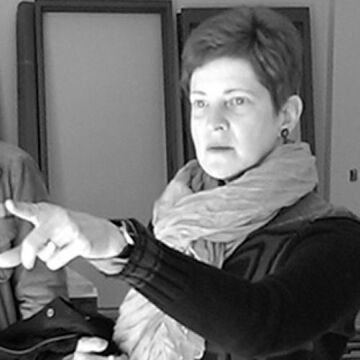

Marlena Novak
Professor, Adjunct
Contact
Bio
Professor, Adjunct (FVNMA). BFA, 1979, Carnegie-Mellon, Pgh; MFA, 1983, Northwestern, Evanston. Exhibitions: National Art Museum of China, Beijing: Translife Trieniale; Streaming Festival, The Hague; STRP Electronic Music and Art Festival, Eindhoven; Centro de Arte Santa Mònica, Barcelona; Haus der Kulturen der Welt, Berlin; Burning Man, NV; Polderlicht, Amsterdam; Experimental Intermedia, NY; Estacionarte, Mexico City; Univ. of New Mexico Museum. Bibliography: TransLife 2011; Erased Walls Biennale; De Bomen van Pythagoras; New York Times; Kolner Stadt-Anzeiger. Collections: Corcoran; Mondriaanhuis; Tweed and Davis Museums; 150 Media Stream; 1 Prudential Plaza. Awards: Center for Interdisciplinary Arts Research; Illinois Arts Council; British Arts Council, Marion Kryczka Teaching Excellence; Illinois Arts Council Agency Fellowship Award in Digital Arts.
Experience at SAIC
I've enjoyed introducing SAIC students' work to appropriate professional venues and observing their artistic growth as they develop in their practice. I believe it's important to be conversant with multiple disciplines as an artist and at SAIC the students are encouraged to do so. As a result, it's a pleasure to work with individuals from a wide range of programs—it makes the texture of the class content so much richer. Additionally, having a chance for students to attend the many informative and varied visiting artist presentations is a valuable part of this learning environment. Becoming acquainted with the work of my colleagues and developing a dialogue with the faculty throughout the School is an added bonus.
Personal Statement
The conceptual basis of my work determines the formation and means of expression. The output is a hybrid comprising installations incorporating interactive technologies, digital video, animation and photography, and socially-engaged activities, often within a collaborative context with scientists, musicians and other artists. I have been grateful for the opportunities to have my solo and collaborative works exhibited in the U.S. and abroad and also represented in museum and private collections. The past several years have been particularly rewarding with exhibitions, presentations and screenings in Amsterdam, Barcelona, Berlin, Beijing, Brussels, Budapest, Chicago, Cologne, Eindhoven, The Hague, Huddersfield, Jerusalem, London, Mexico City, Santa Fe, Taipei, Turin, Tel Aviv, Valencia and Warsaw. I enjoy, in turn, having the opportunity to bring new materials into the classroom from these international experiences as well as to introduce the work of my students to others outside of the SAIC community. Prior to working with the moving image through video, animation and interactivity, I was an exhibiting painter. My teaching reflects this engagement across disciplines.
Current Interests
I'm interested in the ways in which perception functions to address how social, cultural and political boundaries are constructed and interrogated. This has led me to engage with themes as varied as the mating behavior/penis fencing of hermaphroditic marine flatworms, the virtuosity of the European blackbird, the sonification of electric fish from the Amazon, coral reef ecosystems and multiple domains of the human and the non-human, as well as speculative creatures, objects and environments. Concerns addressing anthropocenic topics drive both my artwork and my teaching with a focus on alternate world-building.
Works Hosted on Vimeo
Marlena Novak, Timeslips (2019) Trailer, Video
Marlena Novak, August & September 2019 Featured Artwork Choral, Video
Marlena Novak, Naming Things: Dining Tsars (215-16), Video
Marlena Novak, Naming Things: ...After & Before (2016), Video
Marlena Novak, Bird (2102-2014), Video
Marlena Novak, Frontier (2009-10), Video
Marlena Novak, Naming Things: Shelf_Life [New Nature] (2015-16), Video